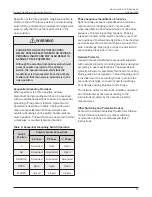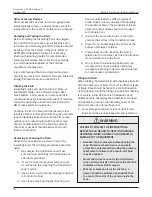
Document 2.4.128, Revision 3
October, 2017
9
Network Transformer Instruction Manual
Lifting and Handling
Lifting hooks are provided near the top of the
transformer tank for lifting. All four lifting hooks
must be used simultaneously. The transformer must
not be lifted from any points other than the provided
lifting hooks. Do not use holes in the lifting hooks for
lifting. These holes are for tie-down purposes only
and are not suitable for lifting. Do not use the cover-
mounted lifting eyes for lifting the entire transformer,
as these lifting eyes are suitable for lifting the cover
plate only.
Transformers should be lifted in an upright position,
allowing the transformer to tilt no more than 15
degrees from vertical. Lifting cables should be
no more than 20
degrees from vertical. Spreader
bars should be used to keep the lifting cables
nearly vertical, enabling a safe lift and reducing the
likelihood of tank deformation or damage to painted
surfaces.
Lifting the transformer with a forklift is not
recommended, since weight and balance can be
problematic and radiator panels can be easily
damaged. Refer to the transformer nameplate
to determine the total weight of the assembled
transformer. Special care must be taken when
handling transformers when the ambient
temperature is below minus 20
°
C (minus 4
°
F);
otherwise, permanent damage to the transformer
may result.
WARNING
FAILURE TO FOLLOW THE INSTRUCTIONS
BELOW COULD RESULT IN DEATH OR SERIOUS
PERSONAL INJURY AND MAY ALSO RESULT IN
DAMAGE TO THE EQUIPMENT.
• Use a crane, suitable lifting cables or
straps, and a spreader bar to unload the
transformer.
• Do not unload using a forklift.
• Keep unnecessary personnel clear while
unloading and moving the transformer.
Jacking
The transformer base is designed for jacking. Do
not use radiator fins, bushings, valves, gauges or
sheet metal surfaces for jacking. Jacking must
be done using the proper jacking provisions from
two adjacent corners simultaneously to prevent
warping of the tank bottom. Do not allow the jack to
come into contact with panel radiators. Refer to the
transformer outline drawing for the total weight of
the assembled transformer.
Location and Mounting
Consult local and national codes to ensure that
the installation meets all applicable requirements.
Location of the transformer must permit it to operate
in conditions that meet the requirements specified
in the “Usual Service Conditions” section of IEEE
Standard C57.12.00. Operation not meeting these
service condition requirements will compromise
transformer capacity and reliability, unless the
transformer is designed specifically for operation
in conditions other than usual service conditions.
Contact the Howard Industries Transformer
Division, if additional information is needed about
location and mounting issues not covered by these
instructions.
The transformer should be mounted on a level
concrete foundation of sufficient strength to support
the weight of the completely assembled transformer
including the network protector and any other
attached accessories. The transformer should sit
flush with the surface of the mounting surface, so
that the transformer’s weight is evenly distributed.
The installed transformer should not tilt in any
direction more than three degrees. Greater tilt may
compromise insulation fluid coverage of live parts
and may prevent insulating fluid from circulating
properly through the cooling radiators. Improper
circulation of insulating fluid may cause overheating
and result in reduced transformer life.
When network transformers are installed in vaults or
compartments, it is necessary to provide adequate
ventilation. The amount of air flow necessary will
SECTION 3: INSTALLATION










































